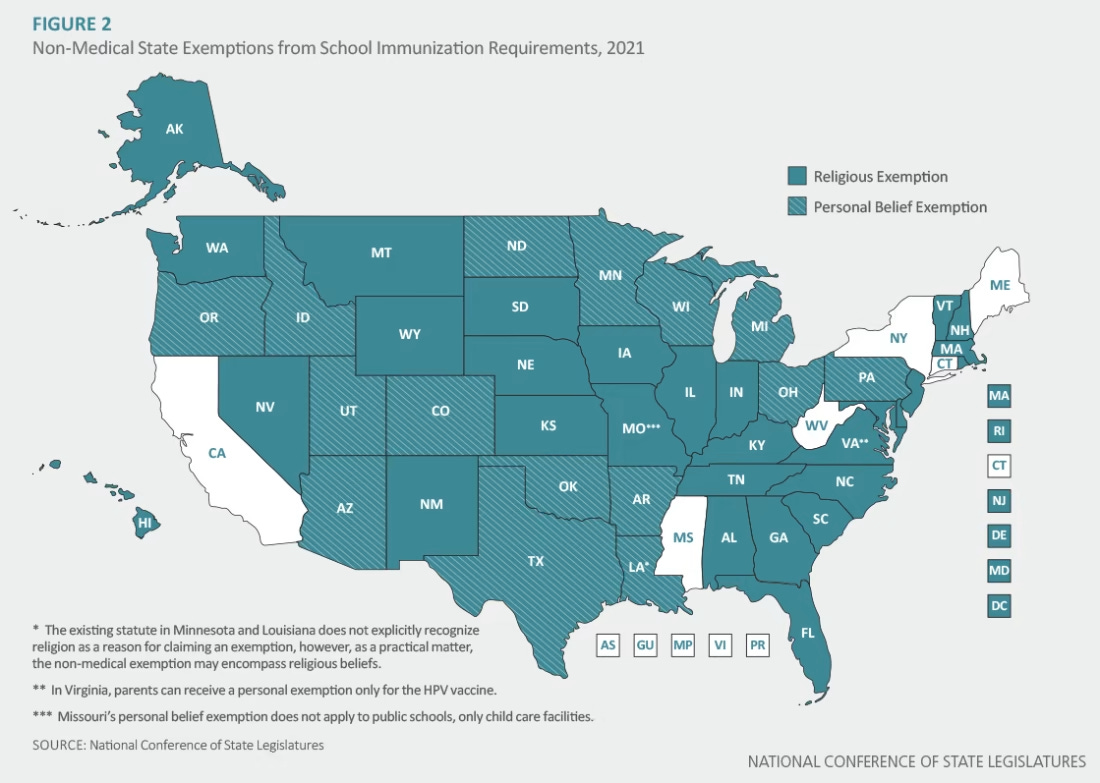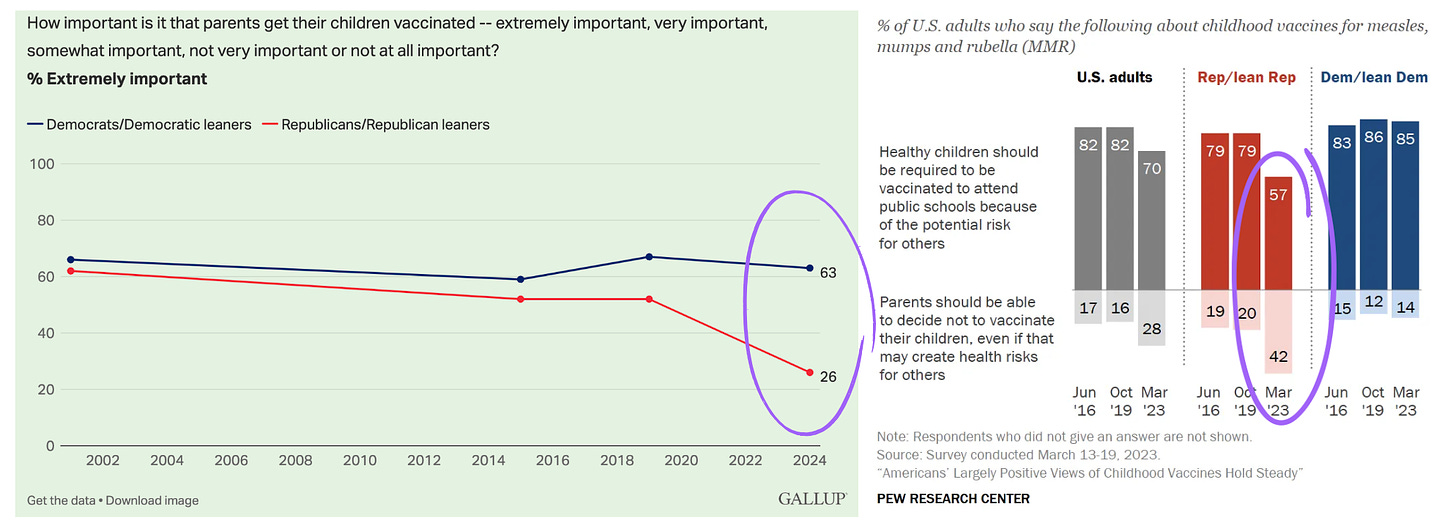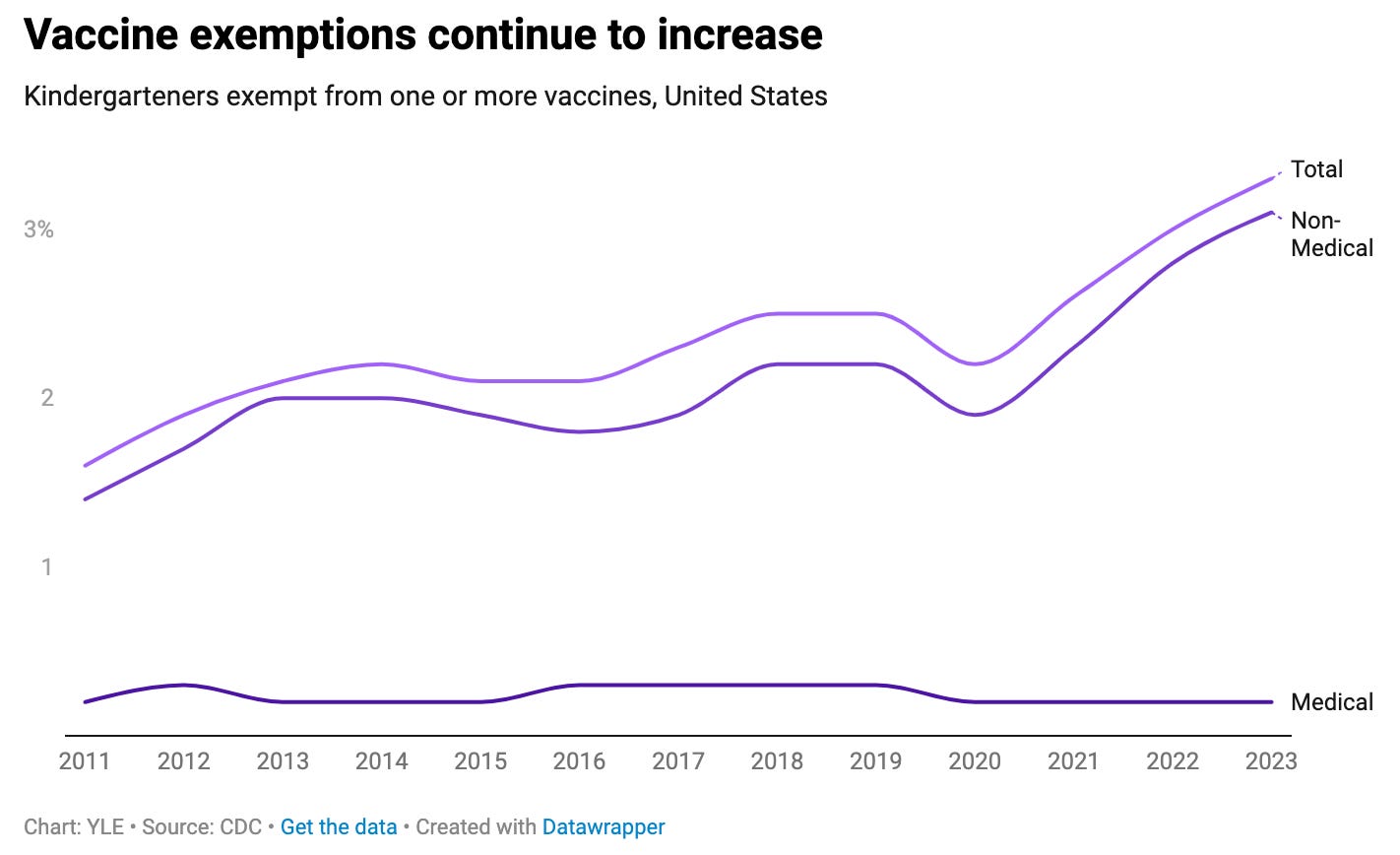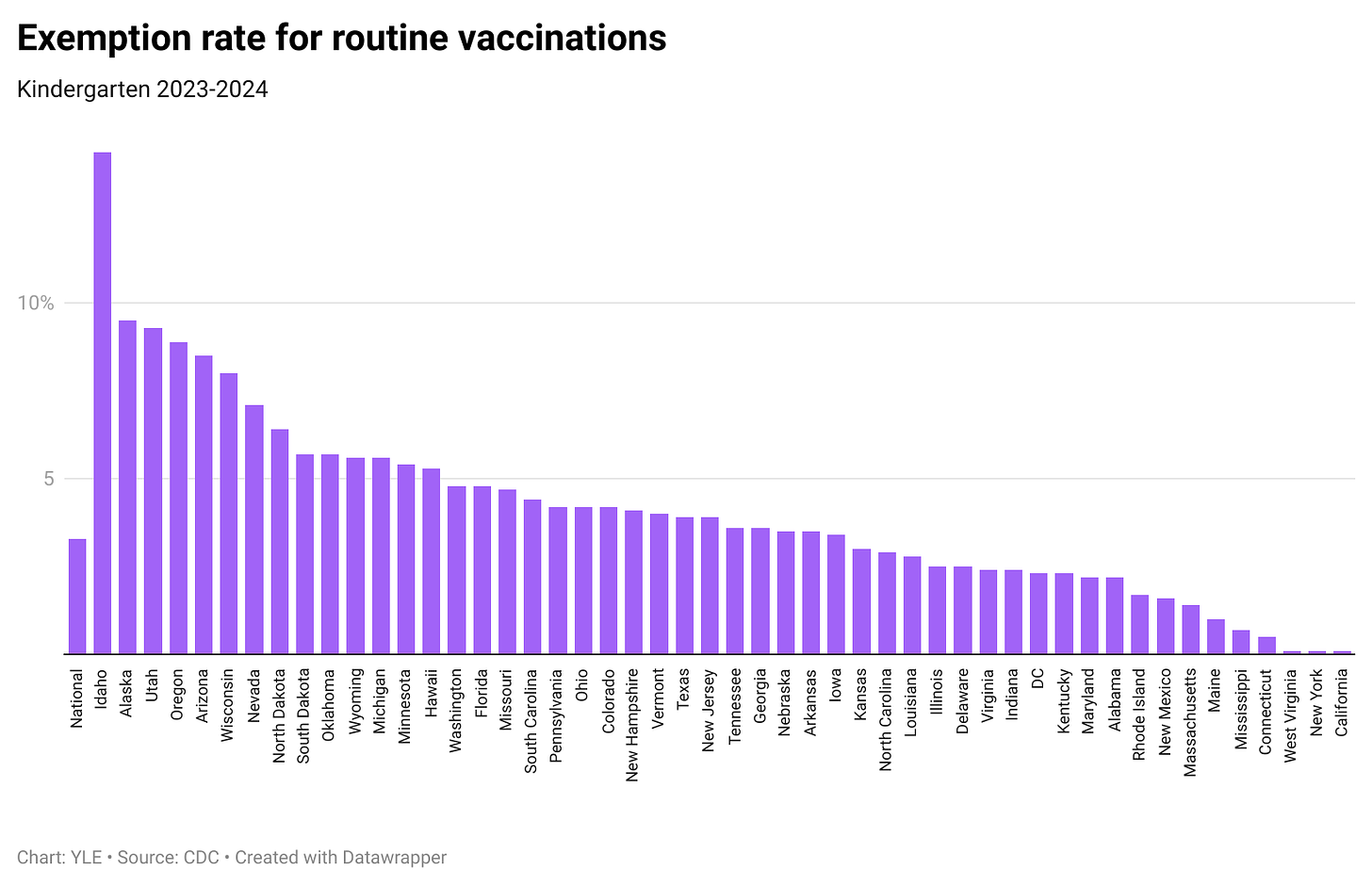The future of vaccine policy in the United States
Common misconceptions and what I'm paying attention to in the future
Vaccines have saved millions of lives over the past century. However, the future of vaccines in the United States—availability, policy, and guardrails—is in question mainly due to the prospect of national leadership by individuals with an established track record of ignoring scientific evidence. This also comes when we see an underlying shift in some perceptions of routine vaccination policies.
We don’t know much right now, but many misconceptions are starting to bubble up on social media. Here are some clarifications on vaccine policy in the United States and thoughts on what I will watch closely and why.
Many, many Americans still support vaccinations
The vast majority of Americans—88%—still believe the benefits of routine childhood vaccines, like the measles vaccine (MMR), outweigh the risks. One statistic I think is greatly underappreciated is that 90% of adults got the first Covid-19 vaccine. When was the last time 90% of Americans agreed on something? This is credited with saving millions of lives in the United States.
In recent years, the strength of vaccine support (% who find routine vaccinations “extremely important”) and support for vaccine mandates across political parties have dramatically shifted. This came to the limelight during the pandemic but has also bled into mandates for routine vaccinations, as reflected in recent national polls by Pew and Gallup.
Vaccine mandates date back to the mid-1800s, when the smallpox vaccine was introduced. Since then, there has been overwhelming evidence that mandates increase vaccine coverage and reduce the incidence of diseases compared to before the mandates were introduced. However, how some weigh this scientific evidence with their values (like the role of individualism vs. collective good) is shifting.
States primarily control vaccine policy, not the federal government
In the United States, vaccine policy is primarily governed by individual states rather than the federal government. Each state has the authority to create its laws and regulations around vaccination, including for school attendance and employment requirements for healthcare workers, public health interventions (like during a pandemic), and medical and non-medical exemptions.
Given strong bipartisan support, there has been little state-level policy variability. To this day, all 50 states still require certain school-entry vaccines, and most states align with the CDC recommendations.
Of course, mandates could be dropped in states in the coming years. But I think what is more likely is changes to vaccine exemptions. Routine vaccine exemptions can be granted for medical and non-medical reasons (religious or personal).
If we pool vaccine exemptions across all states, the percentage of kindergarteners with non-medical vaccine exemptions is still low (3.3%) but has increased since 2011 (1.5%). This equates to about 280,000 kindergarteners not up to date on vaccinations this year.
There is great between-state variability, though. Some states, like Idaho, have reached an exemption rate upwards of 14%. This means that there are more pockets of unvaccinated children, which only need an ember for diseases to spread.
On the other side of the spectrum, five states do not allow non-medical exemptions, and interestingly, they are a mixed bag of political party leanings: California, Mississippi, West Virginia, Connecticut, and Maine.

The rise of vaccine exemptions could impact everyone because infectious diseases don’t see borders. An individual’s decision to get vaccinated changes everyone's risk-benefit calculation. In other words, your probability of encountering measles is low because so many people around you are vaccinated.
Similarly, what happens in one state can directly impact those around it. Even if that neighboring state has a high vaccination rate, vaccines aren’t perfect. Vaccines, like MMR, work well because they are safe and effective and because herd immunity means there isn’t a lot of disease circulating, preventing breakthrough cases.
The federal government can indirectly influence vaccine policy
Although vaccine policy is largely determined at the state level, there are certainly places where the federal government plays a critical role. My biggest questions lie here with the recent elections: What indirect federal levers will be pulled regarding vaccines, where, and how?
There are a lot of possibilities:
FDA determines the safety and effectiveness of vaccines. RFK, Jr. has repeatedly said that he wants a more rigorous vaccine review process, which signals changes in the FDA process. Given that the United States has one of the world’s most rigorous review processes for vaccine safety and effectiveness, it’s unclear what he wants changed or what data would be considered sufficient. More data or review processes could delay new vaccines. The FDA could also remove emergency use authorization (so we wouldn’t get vaccines as fast for the next pandemic). Removing vaccines already on the market is possible. We’ve done it in the past, but only with strong evidence that a vaccine is causing more harm than good. Removing vaccines for other reasons would be very hard to accomplish—it would probably land at the Supreme Court eventually.
CDC determines vaccine policy, including who is eligible for vaccines and when. RFK Jr has long criticized CDC for recommending the childhood vaccine schedule. CDC has an external advisory group of experts—called ACIP—that advises CDC. The HHS secretary selects ACIP members. We don’t know who has been slated for HHS secretary, but Joseph Ladapo is on the shortlist and could select members who ignore scientific evidence as he has in the past. Also, ACIP could be dismantled altogether, as Project 2025 has called for. This could be hugely problematic as insurance companies use CDC’s recommendations to determine what vaccines are covered. Adding cost to routine vaccinations could easily deter uptake. CDC policy also determines the Vaccines for Children (VFC) program, including which vaccines will be free to children. (1 in 2 American children are eligible for this program.)
Of course, there are other indirect levers. For example, Trump suggested using the Department of Education to withhold funds from schools with vaccine mandates. However, given that schools receive 10% of their budget from the federal government, it’s unclear how much impact this would have. And, of course, an indirect lever could not be through policy at all. Continuing to sew doubt and confusion about vaccines from the most powerful office could profoundly impact Americans’ ability to make evidence-based decisions in an increasingly noisy world.
Bottom line
The vast majority of Americans still support vaccinations. However, there are a few key areas to consider if and how vaccine policy will shift in the coming years, which may directly or indirectly impact you. Only time will tell how this may (or may not) unfold.
Love, YLE
Your Local Epidemiologist (YLE) is founded and operated by Dr. Katelyn Jetelina, MPH PhD—an epidemiologist, wife, and mom of two little girls. YLE reaches more than 280,000 people in over 132 countries and has a team of 11 whose main goal is to “translate” the ever-evolving public health science so that people will be well-equipped to make evidence-based decisions. This newsletter is free to everyone, thanks to the generous support of fellow YLE community members. To support the effort, subscribe or upgrade below:








Sadly, Americans that voted for this nightmare have shown that evidence based decision making means nothing!
"I think is greatly underappreciated is that 90% of adults got the first Covid-19 vaccine. When was the last time 90% of Americans agreed on something?"
I hardly believe that you believe this is a logical argument. 90% didn't agree to take it. We may never know how many took it only because their livelihood depended on it, or because they wanted to travel or because they were told that it was necessary to live their lives or protect their loved ones well after our agencies of public health knew it wouldn't stop transmission.
Only about 70% took the second shot of the primary series. Why would that be? Perhaps because their reaction to the first shot was bad enough that they didn't feel a second was worth the risk? Fewer took the first booster and even fewer took subsequent boosters. Right now only about 8% of the public has taken the last updated booster.
The public is smarter than you realize. They know that even if they provided a benefit, it would be for a brief period. We are talking about vaccinating against an RNA virus which mutates much faster than DNA viruses. This has always been an exercise in futility.
We should all ask ourselves how can we possibly know how many lives the Covid vaccine campaign actually saved. The CDC makes no distinction between people who died WITH Covid from those who died FROM Covid. Furthermore these estimations are based on vaccine effectiveness. Where does that number come from? Uh-oh, it comes from mortality rates among the vaccinated vs unvaccinated and once again there is no differentiation between FROM and WITH in regard to that metric either. It's all based in assumptions.
It's really quite interesting that you argue that vaccine mandates are a good thing and exemptions are bad. If you believe the CDC should have the authority to impel our government to mandate a vaccine or any medical therapy upon the public, the public should have the authority to hold vaccine manufacturers liable for damages caused by their product. Anything short of that is medical tyranny.